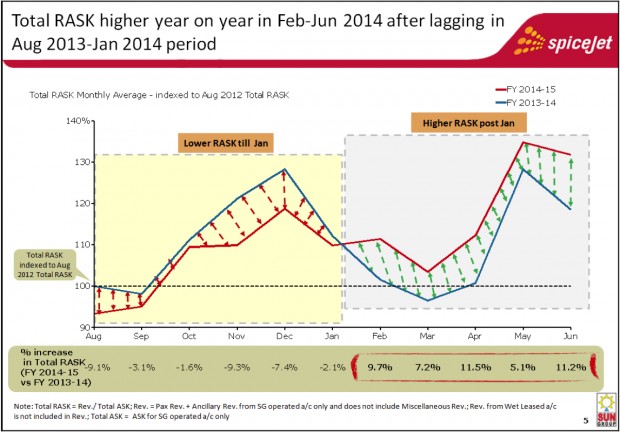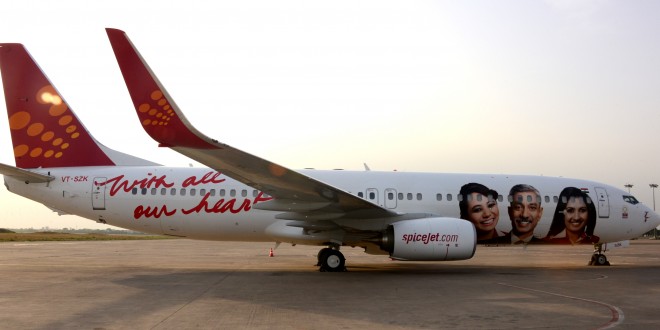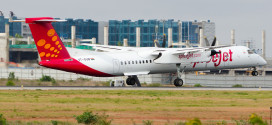Embattled low fare carrier SpiceJet, reported a loss before tax of Rs 124.10 crore (approx. $20.8 million) for the first quarter of fiscal 2014~2015, ended June. This compared to the profit of Rs 50.56 crore in the same quarter a year earlier.
Total income from operations fell to Rs 1,691.04 crore down from Rs 1,701.54 crore in the same quarter last fiscal. Expenses driven by a depreciating Rupee, higher fuel costs, and one-time expenses related to returning five leased aircraft climbed to Rs 1,782.95 crore up from Rs 1,641.93 crore in the first quarter last year.
The airline’s accumulated losses and liabilities now stand at Rs 2,647.85 crore which is Rs. 1,145.57 crore greater than shareholder funds of Rs 1,502.28 crore.
The airline has returned a net of five aircraft to lessors in a bid to rationalise costs. Two aircraft were returned as scheduled, four early, and one aircraft was added to the fleet.
The airline is relying heavily on its on-going measures like route rationalisation, cost-cutting, focus on on-time performance, and restructuring, and in fairness to the company, it is just beginning to showing results. Revenue per available seat kilometre (RASK) is steadily improving. The company though has not released its cost performance figures.
The company addressed concerns of its regular “fare sales and promotions” saying “The revenue results above clearly indicate that our market stimulation efforts are driving not just higher loads, but higher unit revenue (RASK) as well, which is the purest measure of revenue performance as it is the mathematical product of Load Factor and Yield. As a result, SpiceJet’s top line revenue remained constant despite capacity reduction of 8.4%.”

In a statement released after well after normal business hours on the last working day last week, the airline said
[bsu_quote cite=”SpiceJet press release”]Intensive restructuring and market stimulation showing positive results:
- Delivers highest ever RASK (unit revenue) for the months of May and June, driven by high load, improved yield, and growth in ancillary revenues
- Emerges as the #2 airline in India in terms of domestic passenger share in June despite network rationalization that reduced capacity by 8.4% in the quarter
- Across-the-board cost reduction initiatives are well underway, and is the primary focus of the company going forward as the re-structuring continues
MANAGEMENT COMMENTS:
- SpiceJet achieved an operating profit of Rs 9 cr for the quarter (not considering restructuring and certain one-off costs described below) despite an adverse year-over-year impact on expenses of fuel price and foreign exchange rate of Rs 106 cr.
- Positive operating result and share gain despite macro-economic and industry conditions that remained challenged in terms of GDP growth, natural demand, exchange rate, fuel cost, and demand / supply balance, in a quarter which saw addition of capacity and entrance of new player
- On a year-over-year basis, top line revenue for the quarter held steady despite 8.4% reduction in capacity (ASKs) after reduction of five aircraft from fleet (two scheduled, four early returns as part of network rationalization; one new aircraft was also added to the fleet in May); load factor up 2.4%, passenger yield (Revenue/RPK) up 4.8%, and total unit revenue or RASK (inclusive of ancillary revenues) was up 9.4% (RASK is the best measure of revenue performance as it combines both load factor and yield)
- Revenue performance improved significantly month-over-month from April to June (load factor increased from 70.6% in April to an industry-leading 81.4% in June); in addition, SpiceJet’s highest ever RASK was achieved in the months of May and June. The month of April was adversely impacted by ramp-up period for the new network that was launched on March 30, as well as by muted industry and corporate demand given the then ongoing elections
- Ancillary revenues increased 18% year-over-year as a result of higher loads, better ancillary product offerings, and higher conversion of ancillary offerings
- Operational performance remained strong, with SpiceJet ranking in the top 2 or 3 in terms of on-time performance, completion factor (defined as 100% less percentage of cancelled flights), and customer complaint rates (where it ranked #2 in terms of least complaints per 10,000 passengers)
- As a result of high load factors coupled with increased aircraft utilization and strong operational performance, SpiceJet emerged in June as the second largest airline in India by passenger share for domestic travel, despite reduction in capacity deployed
- Operating costs (which exclude restructuring and certain one-off costs) increased 3.2% year over year, driven largely by fuel cost and exchange rate. Excluding fuel and foreign exchange denominated costs, operating costs were down 3.3% year over year
- Both domestic and international networks, as well as both the Boeing and Q400 fleets, were positive contribution for the quarter (inclusive of airport, aircraft and maintenance costs)
- SpiceJet attributes positive operating performance to the positive impact of SpiceJet’s new restructured network and schedule, its investments in brand, marketing, and customer experience, its ongoing cost reduction efforts, and importantly, to its active approach to demand generation via market stimulation through innovative pricing and revenue management
- During the quarter, SpiceJet also incurred restructuring and certain one-off costs consisting of Rs 133 cr relating to restructuring of the network and fleet along with capacity rationalization that required early aircraft lease terminations and associated expenses for four aircraft, as well as additional interest and funding costs driven by unprecedented carry-forward losses from the previous fiscal
- As a result of the above restructuring and certain one-off costs totalling Rs 133 cr, SpiceJet reported a net loss of Rs 124 cr for the quarter ending June 2014.
ADDITIONAL COMMENTS:
- There has been a lot of speculation and numerous comments and questions relating to SpiceJet’s frequent market stimulation efforts, as well as on whether the increase in loads and market share is at the cost of revenue dilution or top line revenue reduction. The revenue results above clearly indicate that our market stimulation efforts are driving not just higher loads, but higher unit revenue (RASK) as well, which is the purest measure of revenue performance as it is the mathematical product of Load Factor and Yield. As a result, SpiceJet’s top line revenue remained constant despite capacity reduction of 8.4%. We believe that SpiceJet’s market stimulation efforts have had a positive impact on the travel industry as a whole by helping increase demand to fill seats that would otherwise go empty, benefitting not just the airline through incremental revenue, but also customers who are getting much more affordable fares if they are willing to book early, and for all other players in the travel value chain due to the increased volume of travel. SpiceJet is the airline that has made flying truly affordable on a pan-India basis for those who are willing to book early.
- In turnaround situations that are accompanied by capacity reduction, the revenue impact of reduced capacity is felt instantly, while fixed costs associated with the previous capacity tend to be more “sticky” and take longer to take out of the system due to contractual obligations, notice periods, and other such constraints. The restructuring and certain one-off costs of Rs 133 cr therefore needs to be viewed in this perspective. Notwithstanding that, SpiceJet’s transformation is well under way, with rationalized capacity, an all new network, strong revenue performance trends, a slew of new products such as SpiceFlex and SpiceMAX to improve yields, and with a massive productivity improvement, increased asset utilisation, and cost reduction program that is currently ongoing to drive all controllable costs down to lowest possible levels.
- Benefits of the intensive restructuring will become increasingly visible in the coming months. It is gratifying to note that these efforts are already paying off: In July 2014 SpiceJet achieved a Load Factor of 79.5%, which is by a large margin the highest in its history for the month of July.
 Bangalore Aviation News, Reviews, Analysis and opinions of Indian Aviation
Bangalore Aviation News, Reviews, Analysis and opinions of Indian Aviation



